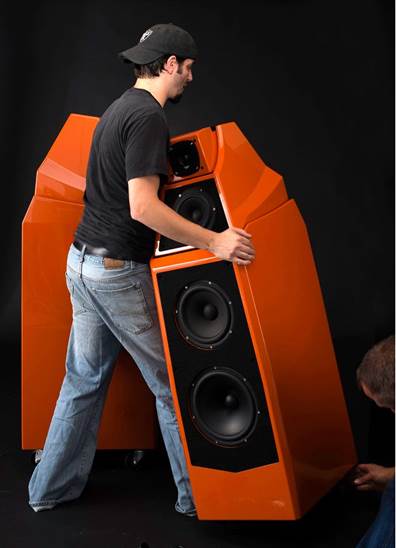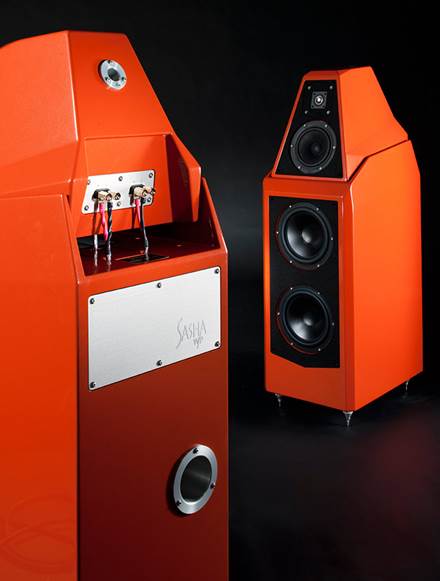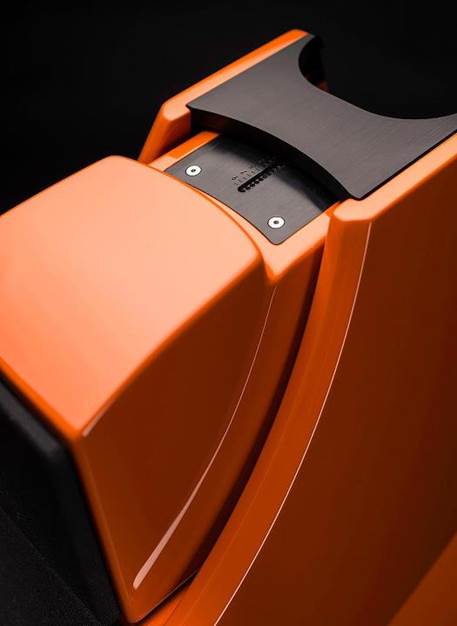Mind the gap
Dave Wilson first remark via a
transatlantic phone call was to state emphatically that ‘price has never been a
motivating factor’ for creating a new model. Although the gap between the Sasha
($41,175) and the MAXX 3 ($102,000) is considerable and it suggests a ‘hole’ in
the catalogue even by high-end pricing standards, Dave says, ‘The Alexia was
not designed to suit a “price point” between the Sasha and the MAXX 3. It was,
in fact, designed to a ‘Size point” that would allow it to be enjoyed in a room
space where a MAXX 3 would be totally out of place. The MAXX is designed to
provide wide dynamic range in larger rooms, including home theatres’. As far as
Wilson is concerned, the Alexia is like Goldilocks’ porridge, ‘just right’ for
us baby bears.

The
MAXX is designed to provide wide dynamic range in larger rooms, including home
theatres
Mono: in depth
Auditioned over a period in two systems,
one Audio Research-based the other powered by darTZeels, both exposed first and
foremost one overriding aspect of the Alexia’s behavior. It’s the sort of
loudspeaker that reveals all one could wish to know about every part of the
audio chain that precedes it. This is what reviewers pray for, and it will come
as no surprise to anyone who understands that a single-word description of
David A Wilson would be ‘analytical’.
It’s not like I fed it disc after disc of
audiophile material. Hell, no: I started out with mono doo-wop, the exquisite
title track from the Cardinals’ The Door Is Still Open (Collectables
COL-CD-9977). Why mono? Because it makes the job of reproducing a recording
both twice and half as difficult: the former, because all of the sounds emanate
from a single point, with no separation in physical space to aid the listener,
the latter because the system only has to resolve one channel…
With the Alexias, the sense of depth,
however artificial, increased over what I knew the Sophias were able to do. I
was reminded of my initial session with the XLF, when Dave indulged in my
monomania and we heard discernible depth portrayed through the prototype with
unmistakable distance in the fore-and-aft plane. However unlikely this may
seem, however ‘impossible’ your logical brain-half wants it to be, the effect
was consistent and repeatable, even though a slice of Spector Ian mass.
Shrinking the XLF
Moveable modules and aesthetic similarities
aren’t the only trickle-down blessings this Alexia inherited from the
Alexandria XLF. Dave Wilson says its Alexia ‘is the second speaker we’ve
released, after the XLF, which has benefited from our recently acquired Bruel
& Kjaer acceleration and vibration measurement systems’. (The new test gear
cost Wilson Audio a cool quarter-of-a-million dollars).
‘Both speakers demonstrate lower cabinet
noise floors than we have previously achieved. This has the benefit of
extending the dynamic range ever further down into the “silence between the
notes”, where so much beauty and interpretative finesse are found.
‘The Alexia is our smallest loudspeaker
which utilizes what I call a ‘full-range Synchromicrometer bandwidth-limited
modulus”, as first employed in 1983 in the original WAMM. Subsequently, it was
used in the X-1 Grand SLAMM and then in the Alexandria. The benefits of this degree
of time domain synchronization include more precise driver blend and coherence
across the audible spectrum’.

Moveable
modules and aesthetic similarities aren’t the only trickle-down blessings this
Alexia inherited from the Alexandria XLF
Wilson is not the first company to
emphasize the importance of the time domain. The history of audio is peppered
with speakers featuring sloped baffles, stepped modules for tweeter and mid,
and corrections via crossovers. Wilson’s approach, though, is more real-world:
the installer fine-tunes the Alexia in the room where it will be used.
Kid in candy store
‘Da Doo Ron Ron’ by the Crystals was the
first recording I ever acquired, now on the bonus disc with the latest reissue
of A Christmas Gift For You From Phil Spector (Sone Legacy 88765433102). Buried
in the ‘Wall of Sound’ are assorted percussive instruments, glorious saxes,
handclaps and a tinkly piano. Oh, and multi-part harmonies gorgeous, lush
harmonies.
It was a kid-in-a-candy store moment. Do I
concentrate on Hal Blaine’s seriously weighty drums? Play masochistic ear-games
by focusing on the piano? Let myself by pummeled by the raunchiest sax this
side of, well, ‘Raunchy’? No need: so transparent and detailed was the sound
radiating from the Alexias that the tableau in front of me had the clarity, the
content and the presentation of a 4K display. I didn’t need to work at it.
Within seconds, I was listening to Bob B
Soxx and the blue Jean’ ‘Why Do Lovers Break Each Others Heart?’ from the same
CD, only a clearer, brighter recording than its predecessor. Opening with a
classic street corner ‘dum-mappa-dum’ rhythm vocal, then massed female voices a
juxtaposition of classic circa-1963 ‘girl group’ stylings with backing that
seemed two decades older made me sit back and marvel. It was as if someone had
a single camera lens optimized for black-and-white, macro, wide angle, zoom and
low-light operation. All at once!

With
the tweeter sub-section extended fully forward, Wilson’s attention to detail is
revealed as truly ‘SME-like’: even the hidden elements are finished to
perfection
What this highlighted was the Alexia’s
ability to juggle myriad ingredients in their original quantities, neither
ameliorating nor exaggerating any apparent anomalies. You heard what was intended,
reinforcing what I suspected about the speaker having the power of a priest
having hearing a confession. No: make that a hardened cop or a deft lawyer ‘the
truth will out’.